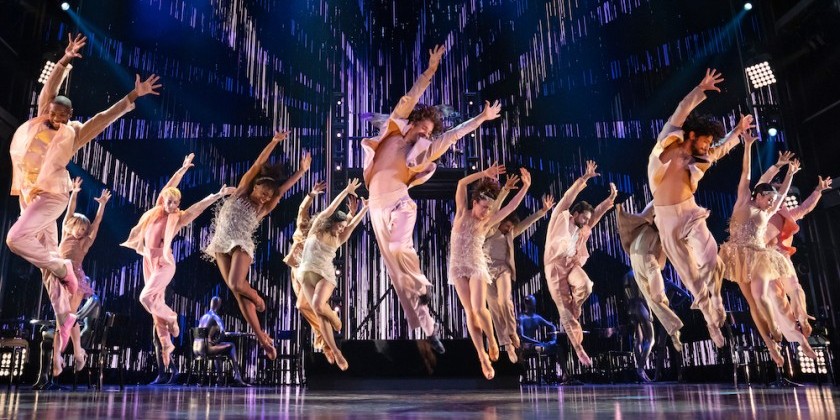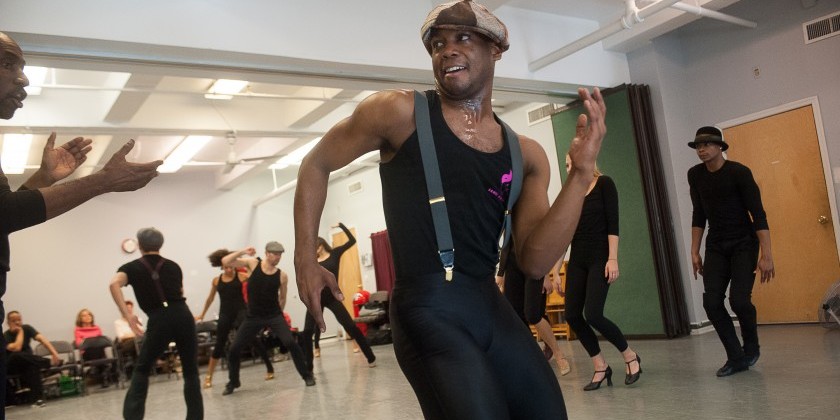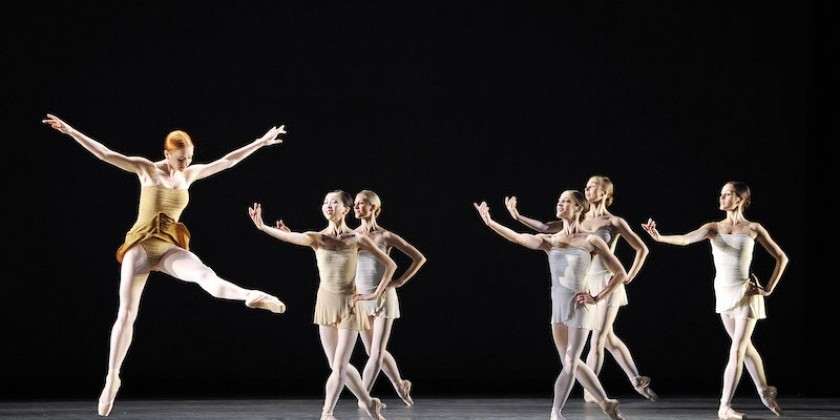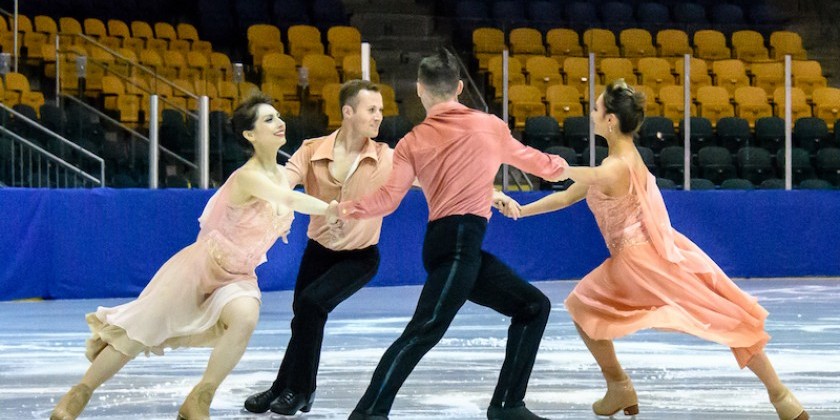Impressions of American Dance Machine for the 21st Century

American Dance Machine for the 21st Century
December 21, 2015-January 3, 2016
Nikki Feirt Atkins, Founder and Producing Artistic Director, in association with Sandra and Eric Krasnoff and The Joyce Theater
Directed by: Wayne Cilento
There has been considerable change and growth since American Dance Machine for the 21st Century (ADM21) made its debut at the Joyce Theater just over a year ago. Margo Sappington, who had been involved in ADM21's development since its earliest showings in 2012, and had directed the 2014 Joyce program, has moved on. Wayne Cilento, the well-known Broadway dancer and choreographer with numerous credits and awards, has directed this year's program.
He has included two examples of his own choreography from the 1990s (numbers from The Who's Tommy and the 1995 revival of How To Succeed in Business without Really Trying) in the repertory of 19 musical-theater (as well as film and television) numbers that are presented at a breathless pace. It's impressive that such rapid and simple transitions have been devised between the numbers, and amazing that the extensive and wide-ranging program clocks in at just a little over two hours.
The brisk pace means that this is an especially demanding program for the 22 performers, most of whom are kept extremely busy. They sing in many of the numbers -- in both solo turns and chorus efforts -- and switch gears on a dime throughout the evening. Having to perform in such a diverse array of numbers in quick succession is a challenge they meet with invigorating energy, even if not every number is performed with stylistic exactitude. Among the standouts were Tyler Hanes, Shonica Gooden (who delivered the strongest vocal performance, in "Sweet Georgia Brown" from Bubbling Brown Sugar), and the tousled-blond vamp, Paloma Garcia-Lee in everything she danced.
The 2015 repertory is mostly different from last year, with only three numbers returning. The excerpts presented certainly represent many of the major names one would list among Broadway choreographers: Agnes de Mille, Jerome Robbins, Jack Cole, Bob Fosse, Michael Bennett, Tommy Tune, Susan Stroman, and Donald McKayle (Gower Champion and Patricia Birch, who were represented last year, are not on the current program.)

One strong impression left by the ADM21 program was what a loss it's been for musical theater that Tommy Tune has been largely absent as a director/choreographer for more than 20 years. The program's two numbers choreographed by Tune made a sensational impression. Both were ensemble numbers, and the ADM21 performers tended to create a stronger impact as an ensemble than in solo turns for which they weren't always ideally suited. Both had clearly been rehearsed diligently and lovingly, so all credit is due to their stagers.
During the first act, “We'll Take a Glass Together,” from Grand Hotel (for which Tune won 1990 Tony Awards in both direction and choreography) marked the first time the audience registered a spontaneously thrilled ovation – and rightly so. It followed a compilation of Jack Cole excerpts, primarily based on a television program, and an attempt to re-create onstage the immortal Gene Kelly-Cyd Charisse duet from Singin' in the Rain. But here was musical theater in all its glory – an exuberant celebration in which a tireless and precise ensemble sang and danced the night away upstage while Tyler Hanes and Mikey Winslow celebrated friendship with tipsy abandon and increasingly loose-limbed moves along a horizontal pole that stood in for a bar. Because I had such strong memories of the original impact of this number (which can be found on YouTube as performed on the Tony Award telecast) especially Michael Jeter's buoyant and touching performance, and his impossibly joyous and seemingly spontaneous dancing, I wasn't sure how this piece would work out of context. But the ADM21 cast wiped all my doubts away.
Kudos to Nikki Harris, who was in the original Grand Hotel cast, and served as Tune's Dance Captain on that and other musicals, for this staging. And high praise as well to Patti D'Beck, who staged “Our Favorite Son” from the 1991 Will Rogers Follies, ADM21's other witty Tune show-stopper, with equal verve. Clever red, white and blue costuming and a wonderfully precise and ebullient ensemble of eight surrounding David Paul Kidder, made every turn of the head, arm gesture, and leg-crossing register vividly.

It was impressive that ADM21 included Agnes de Mille's “Dream Ballet” from Oklahoma (1943), the oldest musical represented on the program. Staged by the veteran De Mille authority Gemze de Lappe (assisted by Elena Zahlmann), its simple directness and gestural fullness resonated beautifully, even with reduced forces compared to what one would see in a full production. Amy Ruggiero, a spitfire dynamo in Twyla Tharp's recent program of new works, made a spunky yet eloquent Laurie, whose hopes and fears spring to life in dance in this landmark number.
Bob Fosse's “Manson Trio” from Pippin received a crackling performance from Shonica Gooden, Skye Mattox and Tommy Scrivens, who delivered its deadpan ironic essence sublimely. It's a taut, brief dance that leaves you wanting more.
To close the program, Donna McKechnie staged “A Chorus Line Medley” that whisked us from the intense opening audition, to the second-act showstopper to the finale. The ultimate musical about dancers – one in which Cilento was an original cast member – this amounted to an anthem to the Broadway gypsy. The Zach-Cassie dialogue that was included when ADM21 performed “The Music and the Mirror” last year was wisely cut, so that this medley was truly all about Michael Bennett's choreography, with all the anticipation, frustration, regret and joy it expresses so vividly.

After already performing such a substantial sampling of musical-theater choreography, the ADM21 dancers blazed through the demanding Bennett opening and finale admirably.
The eight-piece orchestra under the direction of Eugene Gwozdz proved as versatile as the dancers, and made a strong contribution to the program's continuity and verve. The evening's costumes by David C. Woolard were impressive, capturing the necessary essence of the originals and the tone of each work. Scenery was necessarily minimal, but Cilento upped the ante in terms of projections, using them to set an atmosphere or evoke a location whenever possible. He also included projections of credits and information about each number – including the year of each show, and its Tony Award credentials, when relevant. It would have been useful and important, however, to also include the dates of each show in the printed program, which was otherwise quite thorough.
What is an Enthusiastic Event?
Share Your Audience Review. Your Words Are Valuable to Dance.
Are you going to see this show, or have you seen it? Share "your" review here on The Dance Enthusiast. Your words are valuable. They help artists, educate audiences, and support the dance field in general. There is no need to be a professional critic. Just click through to our Audience Review Section and you will have the option to write free-form, or answer our helpful Enthusiast Review Questionnaire, or if you feel creative, even write a haiku review. So join the conversation.













